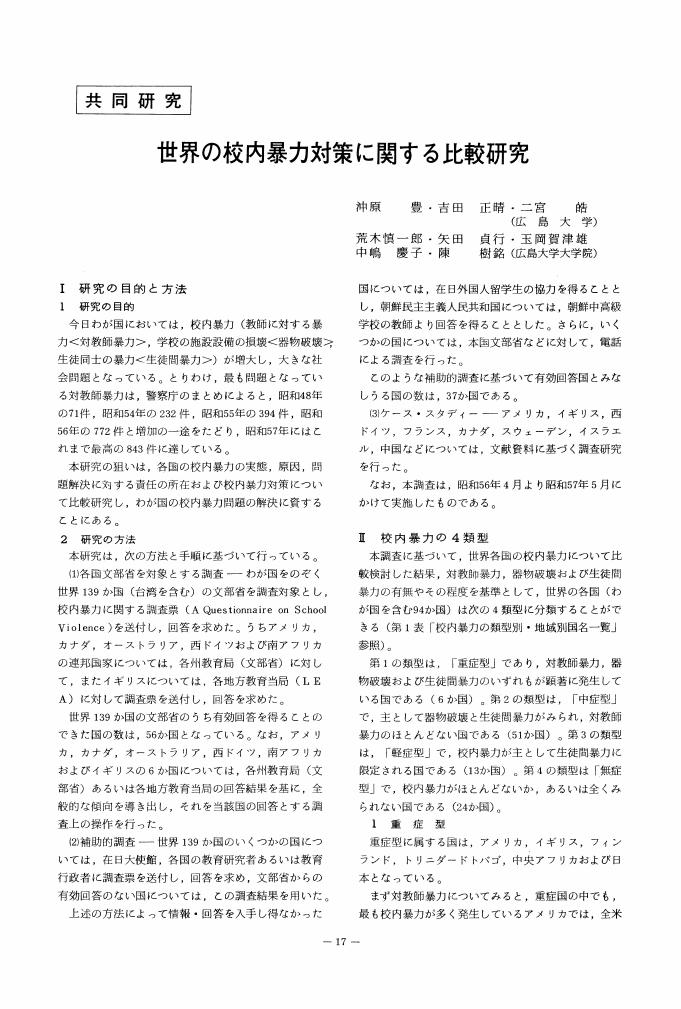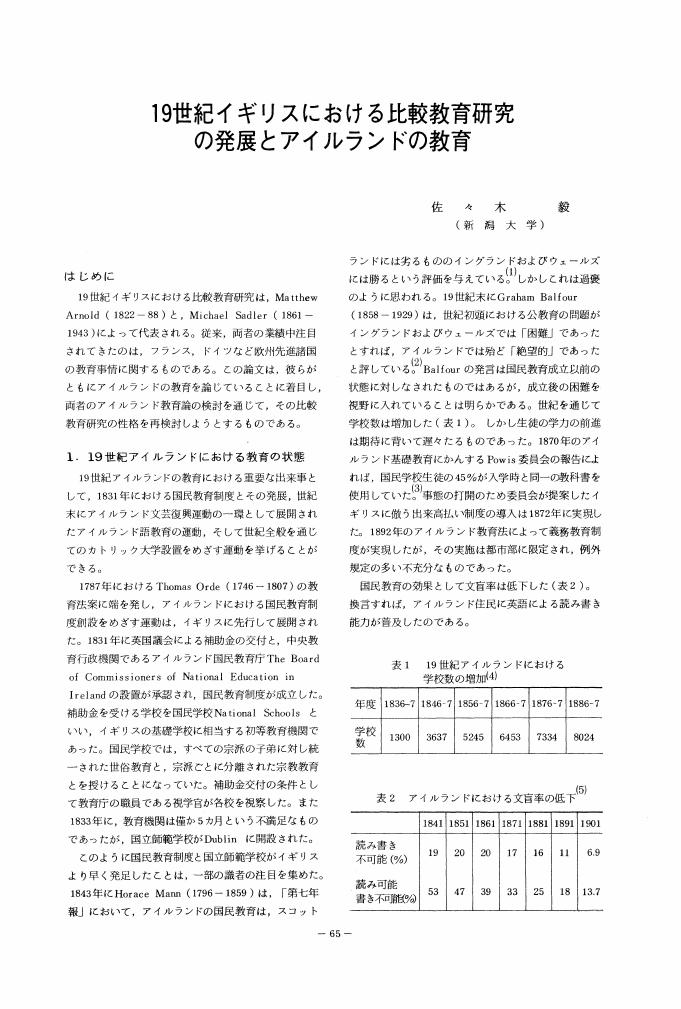1 0 0 0 OA 世界の校内暴力対策に関する比較研究
1 0 0 0 OA 19世紀イギリスにおける比較教育研究の発展とアイルランドの教育
- 著者
- 佐々木 毅
- 出版者
- 日本比較教育学会
- 雑誌
- 日本比較教育学会紀要 (ISSN:02871106)
- 巻号頁・発行日
- vol.1982, no.8, pp.65-71, 1982-03-31 (Released:2010-08-06)
- 参考文献数
- 39
1 0 0 0 日韓両国における国際理解教育の現状と課題
- 著者
- 馬越 徹
- 出版者
- 日本比較教育学会
- 雑誌
- 日本比較教育学会紀要 (ISSN:02871106)
- 巻号頁・発行日
- vol.1978, no.4, pp.8-11, 1978
1 0 0 0 外国人児童生徒の教育を考える:試される日本の学校
- 著者
- 馬越 徹
- 出版者
- 日本比較教育学会
- 雑誌
- 比較教育学研究 (ISSN:09166785)
- 巻号頁・発行日
- vol.1994, no.20, pp.189-193, 1994
1 0 0 0 OA 丸山英樹・太田美幸編著『ノンフォーマル教育―リアルな生活に根ざす教育へ―』
- 著者
- 丸山 英樹
- 出版者
- 日本比較教育学会
- 雑誌
- 比較教育学研究 (ISSN:09166785)
- 巻号頁・発行日
- vol.2014, no.49, pp.213, 2014 (Released:2020-05-01)
1 0 0 0 OA 4. 韓国の道徳教育
- 著者
- 稲葉 継雄
- 出版者
- 日本比較教育学会
- 雑誌
- 日本比較教育学会紀要 (ISSN:02871106)
- 巻号頁・発行日
- vol.1980, no.6, pp.24-27, 1980-03-31 (Released:2010-08-06)
1 0 0 0 OA ドイツにおける学校週5日制
- 著者
- 長島 啓記
- 出版者
- 日本比較教育学会
- 雑誌
- 比較教育学研究 (ISSN:09166785)
- 巻号頁・発行日
- vol.1997, no.23, pp.5-14, 1997-05-30 (Released:2011-01-27)
- 著者
- 中室 牧子 山崎 泉
- 出版者
- 日本比較教育学会
- 雑誌
- 比較教育学研究 = Comparative education : bulletin of the Japan Comparative Education Society (ISSN:09166785)
- 巻号頁・発行日
- no.44, pp.88-108, 2012
1 0 0 0 OA 2. 青少年の生活意識に即して
- 著者
- 藤田 昌士
- 出版者
- 日本比較教育学会
- 雑誌
- 日本比較教育学会紀要 (ISSN:02871106)
- 巻号頁・発行日
- vol.1986, no.12, pp.19-21, 1986-03-31 (Released:2010-08-06)
1 0 0 0 マリオンM. スコットと日本の教育
- 著者
- 古賀 徹
- 出版者
- 日本比較教育学会
- 雑誌
- 比較教育学研究 (ISSN:09166785)
- 巻号頁・発行日
- vol.1991, no.17, pp.43-56, 1991
- 被引用文献数
- 1
1 0 0 0 OA アメリカにおけるホームスクール運動の成長と変容
- 著者
- 長嶺 宏作
- 出版者
- 日本比較教育学会
- 雑誌
- 比較教育学研究 (ISSN:09166785)
- 巻号頁・発行日
- vol.2003, no.29, pp.114-132, 2003-06-27 (Released:2011-01-27)
This paper considers the characteristics of the home schooling movement which rose to prominence in the United States during the 1980s. Home schooling consists of instruction and learning conducted in a family setting in place of attending at school. The numbers of ‘home schoolers’ have been increasing rapidly in recent years, and according to an estimate by P. M. Lines they have reached a total of between 1.5 million and 2million.The growth of home schooling may be explained in terms of two separate movements, both educational and social. Viewed in social terms encompassing political, cultural, and religious elements, it may be thought of as having received strong influences from the new conservatism and the new religious right. The new religious right became a powerful voice in the United States during the 1980s, and this was reflected in the development of home schooling at the time. On the other hand, home schooling also grew as part of an educational movement organized by people who sought an alternative to public education. Criticism of public education had become widespread since the 1960s, and education at home was seen as a means of avoiding exposure to a discredited system.
1 0 0 0 OA イギリスにおけるイスラム教徒の学校教育に関する一考察 -多文化教育の実現に向けて-
- 著者
- 古賀 毅
- 出版者
- 日本比較教育学会
- 雑誌
- 比較教育学研究 (ISSN:09166785)
- 巻号頁・発行日
- vol.2008, no.37, pp.26-35, 2008-06-25 (Released:2011-01-27)
1 0 0 0 OA 茅島篤著国字ローマ字化の研究
- 著者
- 三輪 建二
- 出版者
- 日本比較教育学会
- 雑誌
- 比較教育学研究 (ISSN:09166785)
- 巻号頁・発行日
- vol.2001, no.27, pp.230-231, 2001-06-22 (Released:2011-01-27)
1 0 0 0 OA ロシア・旧ソ連の教育研究の動向と今後の課題
- 著者
- 遠藤 忠
- 出版者
- 日本比較教育学会
- 雑誌
- 比較教育学研究 (ISSN:09166785)
- 巻号頁・発行日
- vol.2001, no.27, pp.55-67, 2001-06-22 (Released:2011-01-27)
1 0 0 0 私立大学授業料に関する日米比較分析
- 著者
- 丸山 文裕
- 出版者
- 日本比較教育学会
- 雑誌
- 比較教育学研究 (ISSN:09166785)
- 巻号頁・発行日
- vol.1992, no.18, pp.129-140,210, 1992
This paper firstly analyzes the relationship between the level of tuition fees and the characteristics defining university quality in Japanese private universities, secondly, compares these results with other research findings gained from a study of U. S. private universities, and finally, examines the differences in higher education policy conerning private university tuition in the two countries, Japan and the U. S.<BR>An empirical analysis uses data related to the following university characteristics: tuition fees, admission selectivity, age of the institution, enrollment, number of faculty members, student/teacher ratio, and an additional six variables. A simple correlation is calculated using these twelve variables, and the tuition fee is regressed on admission selectivity. The results show that in Japanese private universities, tuition fees are positively correlated with selectivity; there is no correlation between tuition fees and the number of students enrolled; and the higher the tuition fees, the larger, strangely enough, the number of students per faculty. Regression analysis gives a figure for marginal tuition revenue in four 'gakubu'(schools); 3, 781 yen in the School of Literature, meaning that the school can expect 3, 781 yen revenue increase per student as the selectivity goes up by an additional one unit; 5, 106 yen in the School of Economics; 11, 193 yen in the School of Engineering; and minus 93, 875 yen in the School of Medicine.<BR>The research results show that the more prestigious the school, the more expensive its tuition in both countries. This can be called the "market mechanism" in higher education, whereby the stronger the demand and the better the quality are, the higher the price (tuition fees). This market mechanism, however, comes into conflict with the social need for highly talented manpower and an equal opportunity policy, because the abler students are likely to be more reluctant to go to presitious colleges and universities, where they will have to pay higher tuition fees. American system resolves this conflict through its strong and varied scholarship programs, while in Japan with its poorer scholarship programs, there is still a problem about providing equal opportunity in higher education.
1 0 0 0 OA 義務教育の機能的変容と回帰の世界動向
- 著者
- 杉本 均
- 出版者
- 日本比較教育学会
- 雑誌
- 比較教育学研究 (ISSN:09166785)
- 巻号頁・発行日
- vol.2009, no.38, pp.38_175-38_178, 2009 (Released:2012-02-29)
1 0 0 0 OA 野津隆志著アメリカの教育支援ネットワ-ク
- 著者
- 斉藤 泰雄
- 出版者
- 日本比較教育学会
- 雑誌
- 比較教育学研究 (ISSN:09166785)
- 巻号頁・発行日
- vol.2008, no.37, pp.181-183, 2008-06-25 (Released:2011-01-27)
1 0 0 0 OA 教育変革における公私協働: イギリスと日本
- 著者
- 宮腰 英一
- 出版者
- 日本比較教育学会
- 雑誌
- 比較教育学研究 (ISSN:09166785)
- 巻号頁・発行日
- vol.2007, no.34, pp.108-123, 2007-01-30 (Released:2011-01-27)
1 0 0 0 OA 近藤孝弘著国際歴史教科書対話
- 著者
- 近藤 孝弘
- 出版者
- 日本比較教育学会
- 雑誌
- 比較教育学研究 (ISSN:09166785)
- 巻号頁・発行日
- vol.1999, no.25, pp.211-211, 1999-06-25 (Released:2011-01-27)












